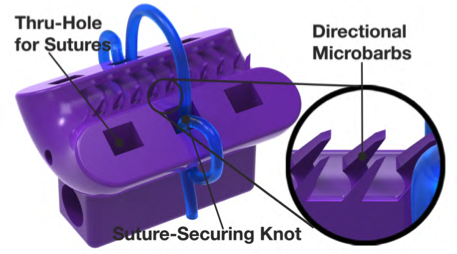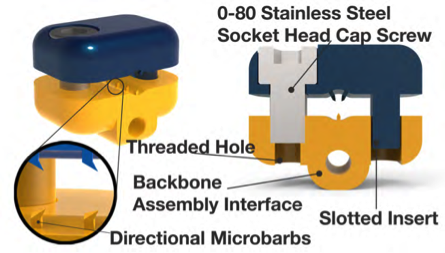Soft Tissue Gripping Device
Background
Nerve injury in the Peripheral Nervous System is caused by trauma, vehicular accidents, repetitive stress, and wartime injuries and affects up to 1% of the U.S. population by age 70. Severed nerves lead to severe pain or the lack of sensation and mobility.
Technology Description
Researchers from UC San Diego have developed a new method to grip soft tissue without damaging it. The clamping mechanisms were developed to grip peripheral nerves, but the concept and approaches may be applied to any number of soft tissues, such as ligament, tendon, and muscle.
The initial practical demonstration of the device was in the context of a nerve lengthening device, for regenerating nerves of the peripheral nervous system. The device grips onto the nerve and elongates it, applying a tensile load which stimulates nerve growth. Appropriate clamping allows the device to impose a tensile load to the severed nerve end. In a non-lengthening context, it also allows the distribution of loads across the clamp, as opposed to across sutures, to protect tissue from physiological or non-physiological movement. This improved nerve gripping mechanism will be able to help those who suffer from severe nerve injuries.
Unlike previous tissue gripping devices, the invention is micro-fabricated, allowing flexible material choice. It also integrates directional surface piercing elements (micro-barbs) into the design, to assist in the attachment between device and nerve. These elements dig into the outer layer of the tissue (for a nerve, the epineurium) to increase attachment strength. The directionality of the microbarbs is a unique feature. The two prototype designs – one of which uses a screw and slotted insert design, and one of which enables the use of sutures or straps to secure the clamp to the tissue – are novel.
Device modularity -- the ability to readily scale and alter the materials depending on the scale and material properties of the tissue clamped – is also a unique to this invention.
 Figure 1
|
 Figure 2
|
- Provides suture-induced compression of the nerve on the clamp channel
- Microbarbs securely clasp nerve outer layer
- Dimensions: 4:0 x 6:1 x 4:6 mm
Figure 2: Screw-Clamp Design features:
- Easy one screw user-interface.
- Slotted insert for proper alignment of the screw.
- 3 rows of directional microbarb to increase friction
- A guide channel for hypotube backbone placement
- Dimensions: 5:0 x 7:0 x 5:0 mm
Each design meets or exceeds key functional requirements
- Reliably clamp onto a severed nerve
- Not excessively compress the nerve
- Distribute radial compressive load along the nerve
- Secure to the existing lengthening system
- Manufactured with biocompatible materials
- Fit within the nerve injury setting, in vivo
This technology is available for commercial development. Worldwide rights available.
Patent Status
| Country | Type | Number | Dated | Case |
| United States Of America | Issued Patent | 10,231,736 | 03/19/2019 | 2015-326 |
Contact
- University of California, San Diego Office of Innovation and Commercialization
- innovation@ucsd.edu
- tel: View Phone Number.
